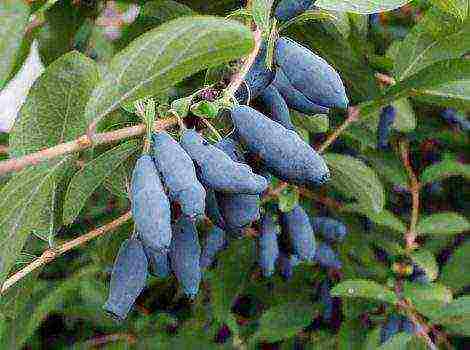Content [show]
The name "oolong" comes from an incorrect translation into English of the name "oolong", which means a group of semi-fermented Chinese teas. There are a lot of Oolongs. When brewed, this tea retains the fresh aroma of green tea. But the pronounced taste is more like red tea. In terms of the degree of fermentation, oolong is in the interval between green and black, therefore, it is singled out in a separate category. In ancient times, the Chinese attributed miraculous properties to it. Currently, researchers from around the world have confirmed that tea is truly unique, it can be called a "health elixir".
What is oolong (oolong)
It should be understood that oolong is not just one type of tea. This is a large group of teas that grow in southern China, only in the two provinces of Guangdong and Fujian. In Guangdong province, dark varieties of oolongs are harvested, in Fujian province - dark and light. The best varieties are harvested from Mount Uy and the Phoenix Mountains. Some varieties of oolong are also grown in Taiwan, but they differ from the Chinese in both taste and price.
Light oolong tea should be distinguished from green tea, although both have a rich green color. But oolong tea leaves are always wrinkled, this is required by the production technology. Whole green tea leaves. The taste of green tea is herbaceous, with harsh notes of greenery. Oolong tea gives aroma and taste of spring, flowers, freshness. After tasting different types of green tea and oolong, you can immediately feel the difference.
Dark oolongs are distinguished by the fact that at the final stage they are tormented on charcoal. The tea leaf becomes dark, the resulting drink is cognac-colored, spicy notes are felt in the taste. Dark oolong tea is often confused with red tea, but the appearance of red tea leaves is smaller, they are made only from the buds, while oolong tea is a large leaf tea. The aroma of red tea is soft, chocolatey, while dark oolong has a tart, rich aroma.
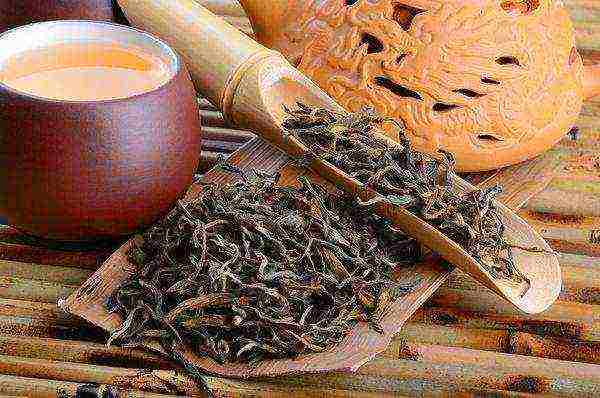
Oolong varieties
A real Chinese oolong is one made from rolled whole leaves. If dust and broken leaves are present, it is a fake.
- The most popular and affordable Oolong variety is Tie Guan Yin (Iron Bodhisattva). Tea grows in Fujian and Anxi provinces. If you inhale the aroma while brewing, you can feel the floral-honey notes.
- Dong Ding Oolong is a tea native to Taiwan. Its tea masters use it during tea ceremonies. Oolong tea has a floral and fruity aroma.
- Huang Jin Gui (Golden Cinnamon) is popular in China. The tea is composed of tightly rolled tea leaves. The brewed tea turns out to be light in color, but it darkens by 5-7 brewing. The aroma of the drink is stable and subtle.
- Zhou Gui, translated as Cinnamon from the Wuyi Mountains, is the famous tea of China, it is grown on an area of more than 400 hectares. The tea has a milky aftertaste, long aftertaste, light cinnamon aroma.
- Da Hong Pao (from the whale "Big Red Robe") is an elite dark oolong. Contains many trace elements and vitamins, helps to rejuvenate the body. The taste is invigorating, full-bodied with a woody aftertaste.
- Bai Zi Guan (from the whale "White cock's comb") is a cliff oolong tea that grows on Mount Wuyi.
Oolong billet and manufacturing technology
Oolong tea is a semi-fermented tea with a degree of 40-60%. Only mature leaves are harvested by hand. The collected raw materials are laid out in the sun in a small layer. The leaves should wilt, but not much. The process takes no more than an hour. Then the leaves are transferred to wide bamboo baskets, which are placed in the shade. Periodically, the leaves are stirred and kneaded, but carefully so that the structure of the leaves is not damaged.
After the leaves begin to turn brown, the fermentation must be stopped by calcining with hot air. The finished oolong should look like twisted balls, when brewed, they bloom in whole leaves.
Useful properties of oolong
Oolong tea contains a large amount of antioxidants, it has the ability to fight free radicals that cause aging in the body. It is recommended to drink oolong tea for atherosclerosis, so that it removes bad cholesterol and cleanses blood vessels from plaque. This is an excellent prevention of stroke and heart attack, hypertension.
Oolong helps to remove triglycerides, they impair the work of the heart, clog blood vessels. Studies have shown that drinking tea increases the content of adiponectin, a protein that causes heart disease and diabetes.
Oolong is also known to have anti-cancer activity. Tea leaves contain polyphenols that can reduce the activity of growing cancer cells. Tea activates the digestive tract, improves digestion.
Oolong tea in the fight against obesity
The beneficial properties of oolong include the ability to improve metabolism. With physical exertion, with regular intake of tea, you can lose 2 times more calories than when taking other types of tea. Chinese scientists have conducted a number of studies. Women were given a cup of oolong before eating, and it was found that they spent 10% more calories during meals, the indicator did not depend on physical activity.
Oolong tea helps relieve stress, improves mood, and this is very beneficial, since people who are on diets become depressed. Tea will get rid of allergic rashes, improve skin condition.
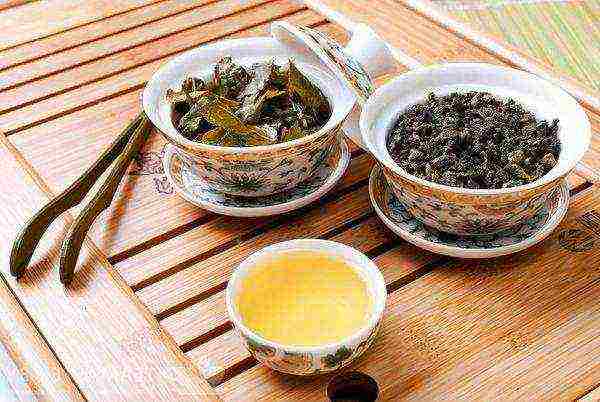
How to brew oolong
The tea ceremony - Gongfu Cha - is dedicated to the process of brewing oolongs in China. It is conducted by specially trained tea masters. The ritual uses a large number of utensils intended only for this ceremony. Gongfu Cha is the supreme art of oolong brewing. But it is very difficult to repeat it at home. It is better to simply follow certain rules so that during brewing all the beneficial substances that oolong tea is rich in are not destroyed.
The water temperature varies. When fermentation of tea is less than 40%, when the leaves are green, the water should be 80-85 ° C. When fermentation is more than 40%, the water can be hot - up to 95 ° C.
For brewing, a clay teapot is best, but you can use a porcelain or glass one. It must be warmed up with boiling water, after which 7 g of tea leaves must be poured into it. Then pour prepared water and shake the kettle in a circular motion. The tea leaves will be rinsed with water to cleanse it and help the scent to unfold. Water is poured out immediately, you do not need to drink it. The tea is immediately poured over with a new portion of water. After half a minute, it is poured into cups.
The first brew is an introduction to Oolong. The first brew is followed by the second, then the third. A good oolong tea can last up to 7-8 infusions. The infusion time with each infusion should be increased by 30 seconds. Each time you can feel a new taste of this amazing drink, enjoy a new aroma and aftertaste.
Similar articles
Oolong (Chinese trad. 烏龍, exercise 乌龙, pinyin: wū lóng, "dark dragon"; oolong and oolong - erroneous transliteration from English), or qing cha ("Turquoise tea") - semi-fermented tea, which, according to the Chinese classification, occupies an intermediate position between green and "red" (that is, black).
According to the classification according to the degree of fermentation, it is fermented by 50% (ideally). When processing it, fermentation is not completed: not the entire leaf is exposed to it, but only its edges and part of the surface. At the same time, the inner layers of the tea leaf retain their intrinsic structure and are not fermented. Therefore, it is believed that "oolong" combines the properties of both green - a bright aroma, and red - a rich taste. There are two subspecies - closer to green (less fermentation) and closer to red teas (more fermentation).
The history of these teas is about 300-400 years old. This type of tea is used during the ceremony "gong fu cha", which can be translated as "the highest tea skill".
Description
It is produced in China in three locations: in the south and north of Fujian, in Guangdong and on the island of Taiwan. In the south of Fujian and Taiwan, weakly fermented oolongs (less than 50% of fermentation) are produced, in the north of Fujian and Guangdong - highly fermented (more than 50% of fermentation) oolongs.
It is traditionally believed that highly fermented Oolongs appeared earlier. The best varieties are alpine, traditionally the Wuyi Mountains of Fujian Province and the Phoenix Mountains of Guangdong Province. Such teas are made from raw tea tree-like shrubs of a certain type, the leaf must be fully developed and fleshy. The best varieties are obtained from the so-called "mother bushes", from which the original variety of such tea originated. In the north of Fujian, the best representatives are: Da Hong Pao, Te Lo Han, Bai Ji Guan, Shui Jin Gui, etc., Guangdong - Feng Huang Dan Cong.
Low Fermented Oolongs are made from raw materials from tea bushes, and the best are alpine ones. Top Representatives: Tie Guan Yin - the most popular and well-known variety, southern Fujian; Dong Ding, Cui Yu, Alishan, Shan Lin Xi - Taiwan. Also made from fully developed fleshy leaves.
You can also select a separate view - flavored oolongs, are flavored with ginseng, fragrant osmanthus flowers, rose petals, extracts of different quality are used for flavoring. Most often, such oolongs are made on the island of Taiwan, the history of tea production there is about 40 years old, there are a lot of experiments with tea processing, which combines both classical and modern methods. Such oolongs are made for sale, the Chinese themselves appreciate the original taste of the tea leaf and believe that aromatization "spoils" the tea.
Milk Oolong (奶香 金 萱 - Nai Xiang Jin Xuan) is a type of tea developed in 1980. It differs in the type of fermentation, but flavored oolong tea may be sold under the same name.
One of the successful tea experiments is Lao cha, or aged oolongs, aging occurs naturally according to a certain technology (such is more valuable) or with the help of heat treatment. Representatives: Lao Te Kuan Yin, Lao Cha Wang.
The best time for collecting such tea is autumn, then the tea is balanced in aroma and taste, spring teas are inferior, such teas are more aromatic, but not deep enough.
Manufacturing technology

Tea Leaves Drying Oven
Unlike many other types of tea, which use the top leaves and leaf buds with white villi (bai hoa, hence “baikhovy”), oolong tea is made from juicy mature leaves harvested from mature bushes.
The collected leaves are dried in the sun for half an hour or an hour. Then the dried leaves are placed in a thick layer in baskets and placed in the shade for fermentation. The key point in preparation is that during fermentation, the leaves are gently mixed and kneaded every hour, while being careful not to break. Such processing leads to uneven fermentation - mostly from the edges of the leaves.Depending on the duration of the process and the characteristics of the raw materials, a different degree of fermentation is achieved - from 20% to 60% (for most oolongs, it is in the range of 40-50%).
After reaching the desired degree of fermentation, it is interrupted by heating - the leaves are dried at a temperature of 250-300 ° C. Usually, drying is carried out in two stages - first, the leaves are briefly dried for several minutes, then curling is carried out, after which the tea is dried to reduce its moisture content and finally stop fermentation. The resulting tea is packaged and sent for sale.
The characteristic features of the oolong processing technology make it possible to quite easily determine the authenticity of tea - real oolong is always whole-leafed, it should not contain broken leaves, crumbs, dust, and its leaves, unfolding during the brewing process, have a characteristic appearance - the edges are dark, like a black leaf tea, and the leaf veins and some part of the leaf in the middle part are green and retained their structure and strength. However, the characteristic taste of oolongs makes them very difficult to counterfeit.
Properties
In addition to its high taste and aesthetic qualities, oolong teas affect physical health. Oolong tea is distinguished by good extractability, contains a large amount of essential oils, is also distinguished by tannins, the caffeine content in highly fermented teas is higher than in weakly fermented ones. Oolongs contain more than 400 types of chemical compounds useful for the human body. The main ones are: polyphenol compounds, caffeine, vitamins C, D, E, K, B1, B6, B3, B12, calcium, phosphorus, iron, iodine, magnesium, selenium, zinc, manganese, etc. Manganese promotes the absorption of vitamin C by the body , strengthens the body's resistance to disease. The rich content of vitamins in oolong tea helps to strengthen the fibrous tissues of the walls of blood vessels, prevents thrombophlebitis.
Organoleptic characteristic
Weakly Fermented Oolongs: the weakest degree of fermentation is in the Taiwanese Wen Shan Bao Zhong: the leaves of this tea are light green, elongated, slightly twisted, there are flushes - the upper parts of the tea shoots. The aroma is bright floral, there are creamy notes and notes of young corn.
Usually tea leaves have the shape of a ball of light green color, the degree of twisting is different. Such tea is made from flushes, that is, when brewed, it fully unfolds and you can see three leaves on one "branch" and such tea usually occupies the entire volume of the dishes. The leaves are whole, in some varieties there is a stalk - Tie Guan Yin; veins are visible. In high quality varieties, the red edges of the leaf and the green belly - the center of the leaf - are very clearly visible.
The aroma of dry leaves resembles green tea, usually the aroma of oolong teas is very bright. Infusion: bright yellow, there are green, pinkish shades, transparent. It can be as thick as honey in high varieties. The aroma is intense, rich, full, with bright tints. Bright floral, honey, fruity notes, creamy shades are found. The taste is soft, full, slightly herbal, there is a woody - astringent note, a memorable aftertaste.
Highly Fermented Oolongs: Taiwanese Dong Fang Mei Zhenya has the strongest degree of fermentation, he is closest to red tea: the leaves of this tea are dark brown, there are buds covered with white pile, the raw materials are heterogeneous. The aroma is bright honey, shades of rose, berries, the taste is very similar to red tea. Wu Yi Zhou Gui can also be attributed here: the leaves are dark brown, longitudinal twist. The aroma is bright, deep, spicy honey-berry taste, bright aftertaste.
Usually tea leaves are elongated, voluminous, longitudinal twist, color - various shades of brown with green, blue and gray shades. Moreover, in some varieties, the leaf may turn pale green when brewed - for example, Bai Ji Guan.The aroma of dry leaves is strong, sweetish-spicy. The color of the infusion is yellowish-brownish, amber, hue of buckwheat honey, transparent. The taste is full, bright, hints of honey, spices, woody astringent notes, honey, chocolate, berry, etc. Complex memorable aftertaste. If we look at the leaf of a sleeping tea, then there we can also see the veins and the red edge and the green "belly" - in tall varieties.
Flavored oolongs: Made from low-fermented oolong teas, teas are generally of average quality. Artificial aroma can clog blemishes in tea production, the aroma itself can be of different quality. This product is completely exported and is not used in China. The taste of this tea is reminiscent of the taste of good Indian green tea with one note of flavoring throughout the entire tea drinking. The difference between good Chinese tea is that its taste changes throughout the entire tea drinking. The shape of the leaf can be different, most often - a leaf rolled into a ball; in the case of ginseng oolong, the tea leaves are covered with licorice and ginseng gruel and resemble pebbles.
Aged oolong teas: Made from low-fermented oolongs, the leaves are rolled into balls, the color is dark brown. The aroma of a dry leaf is spicy, strong, there are coffee, woody-chocolate notes. The taste is strong, invigorating, bright honey, hints of dried fruits, there is a light peppercorn. A memorable aftertaste.
Brewing
Oolongs are brewed in different ways, depending on the degree of fermentation. Less fermented oolongs are brewed with not too hot water 60 ° -80 °, brewing time up to 3 minutes. The more fermented ones require a slightly longer brewing time, and can be brewed at temperatures up to 90 °. It is best to brew tea in teapots made of Yixing clay, they are made specially with thick walls for such tea, in order to create a good temperature environment for its opening. Such teapots are usually small in size, tea is poured into a third of the teapot, and water is two-thirds. Pour boiling water and drain the infusion about 7 times. But this is an average value for the amount of infusion, tea can be different in volume and weight. Most often they take 4 grams per 150 ml of water when brewing in a teapot or gaiwan. Such tea can also be brewed in ordinary porcelain teapots like regular tea, that is, 1 teaspoon of tea per person + 1 per teapot.
Storage
Such tea is stored in an airtight container with a well-ground lid, ceramic, glass, tin without access to light and moisture, as well as strong odors, since the tea absorbs them well. From the moment of harvest, Taiwanese oolong tea can be stored for one year in the freezer at a temperature of -20 degrees, after a year the tea is considered stale and is not suitable for the production of flavored tea.
Famous varieties
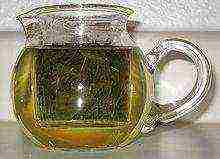
There are no more than thirty varieties of oolongs known, all of which are produced exclusively in China. According to their quality, they are divided into categories: the finest, the finest, the finest, the subtle, the highest, the beautiful, the good and the ordinary. The following is a description of the best representatives of the category of oolong teas, the tea "classic". All these teas (except for Taiwanese ones) have their own history, their outstanding qualities are generally recognized. These teas are best suited for attentive tea drinking. However, such teas are most often counterfeited or simplified production technology. Legends about such teas often mention their medicinal properties.
- Tie Guan Yin is a Chinese low-fermented oolong. The color of the infusion is from pinkish-yellow to amber. Strong enveloping honey-orchid aroma, full (but without excess), bright taste, memorable long aftertaste. A beautiful organic tea with rich flavors and strong effects. Feature - withstands up to twenty brews, subject to the cooking regime and the use of special dishes.Very expensive and rare tea in the right way; now the technology of making such tea is being simplified, and such tea is very different from the traditional one.
- Da Hong Pao is a Chinese highly fermented oolong. It is also called the "Big Red Robe"; contains a huge amount of vitamins and minerals, helps to cleanse and rejuvenate the body. The color of the infusion is golden brownish. The aroma of dry leaves is spicy, sweet-woody, chocolatey. The taste is full, rich, invigorating, with bright flavor nuances. Woody aftertaste. This tea belonged to especially valuable varieties, since it grew only in one place - on the slopes of Mount Wuyishan. At an altitude of about 600 m above sea level in Fujian province, tea was fermented. The real Da Hong Pao can no longer be bought, the last crop from the mother bushes was donated to the Tea Museum, and now this tea is made from the descendants of the mother bushes.
- Peng Feng is one of the most famous Taiwanese oolong varieties. The name comes from the name of the province in Taiwan where it is grown. It is a highly fermented oolong tea with a characteristic spicy flavor and aroma. The infusion has a golden yellow color, for which Taiwanese oolongs are sometimes called "champagne teas", and a characteristic spicy aroma.
- Gui hua - oolong, flavored with the flowers of fragrant osmanthus. Low-fermented tea with fruity notes.
Notes (edit)
- ↑ The name "oolong" is a transliteration of the English name - oolong. The original Palladium Chinese name wūlóng should be transcribed as "oolong".
- ↑ Oolong tea is also called "qing cha", which can be translated as turquoise, coal black, blue-green; in addition, this hieroglyph means "flourishing", a state in which something is at the peak of vitality.
- ↑ Kucher, Svetlana... Milk oolong tea - benefits and harms, how to brew oolong (Russian), Alternative to medicine: health and beauty without drugs (January 14, 2017). Retrieved July 30, 2017.
Links
- Oolong history (oolong)
- milk oolong for weight loss
Julia Vern
Oolong tea falls into the category of semi-fermented beverages that rank between green and red tea, depending on the degree of fermentation. This tea drink is one of the most revered in the famous Chinese tea ceremony, which gives it a high rating among the teas around the world.
Due to its ability to change its color, oolong was given the metaphorical name "Black Dragon". Another name for the drink - "oolong" appeared due to the specific English pronunciation of the word "oolong".

Dried oolong looks like curled lumps
Oolong origin story
Anxi history
The first oolong varieties were cultivated and specially made in the Anxi province of southern China. According to this theory, tea got its name from the name of the person who first made it - Sulun. Actually, tea was originally called that, but over time, due to the peculiarities of many Chinese dialects, tea turned from sulong to oolong.
Another legend says about a certain hunter named Black Dragon, who, carried away by hunting, forgot about the existence of several tea leaves in his bag, which eventually oxidized. The Black Dragon wanted to throw them away, but changed his mind and welded them. The drink seemed to him so fragrant and delicious that he decided to present this method of brewing to his friends, who named the tea in honor of the Black Dragon hunter.
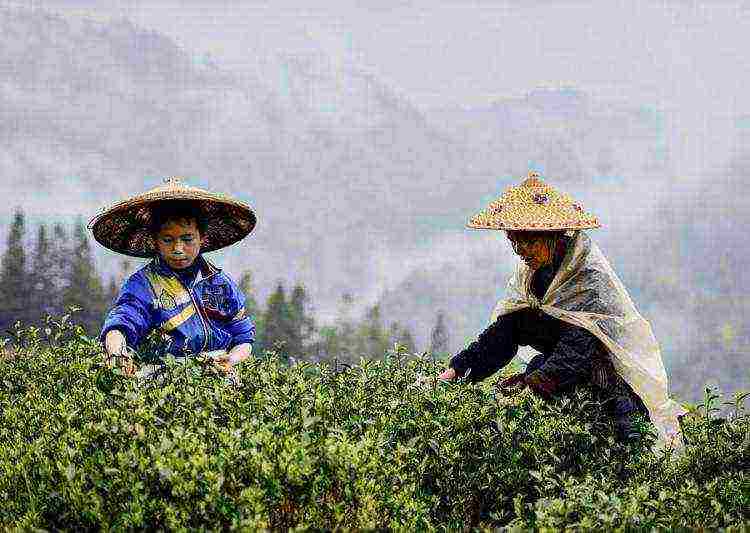
Collecting leaves on a tea plantation
History of "Gun-Cha"
Gong Cha (tea offering, tea-offering) is a specific ritual of ancient Chinese traditions, interpreting the separate cultivation and preparation of the best varietal teas especially for the emperor and his family. According to ancient Chinese chronicles, the tea offering took place as early as 1000 BC.
It was thanks to Gun-Cha that a method was invented for making a luxurious, magnificent tea drink - oolong, in one kilogram of which about 180 thousand of the finest tea sprouts were contained. To collect tea, tens of thousands of peasants gathered on the plantations, who with great diligence selected the best young sprouts of green oolong tea for their beloved emperor.
For a thousand years, tea masters have come up with new varieties of oolong, selecting the best ones. Oolong tea revealed more and more originality and richness of a fragrant bouquet. Many ancient ways of growing and preparing oolong have survived to this day.
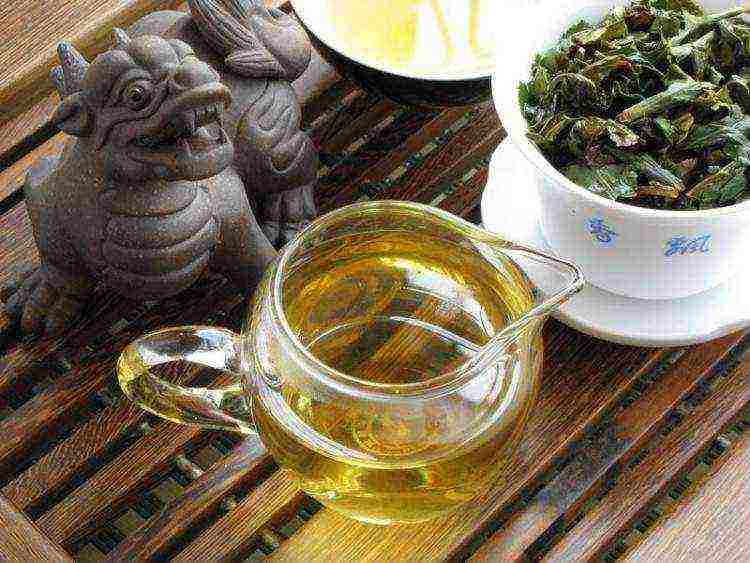
Milk oolong has a pleasant aftertaste with a slight milky undertone
History of the Ming dynasty
Fujian Province in southeastern China has long been famous for the richness of the cultivated teas and the ingenuity in their preparation. This status is facilitated by the special mineral composition of the soils of the mountain slopes where tea is grown, which makes the province ideal for tea production.
According to the sources, the origin of the oolong variety, according to this version, dates back to much later dates, relative to other teas. The Emperor of the Ming Dynasty (1368-1644) unexpectedly introduced some serious restrictions on the production and distribution of tea, thereby trying to reduce the number of falsifications in the tea market and the corruption component. However, this did not bring the desired effect. The Chinese were so fond of tea that the imperial prohibition hid only the appearance of its use.
State inspections and confiscations of equipment for the production of tea, especially briquetted ones, led to the extinction of the development of tea traditions and reduced the volume of new methods of making it. But at the same time, it has contributed to new, simpler approaches to production technology, carried out almost at home.
Thus, a new method of making tea was born with pre-drying on charcoal fired, which promoted the natural oxidation and fermentation of tea leaves. Dried in this way, the tea leaves darkened and curled into tubes resembling a dragon, which gave another explanation for the second name of this variety.
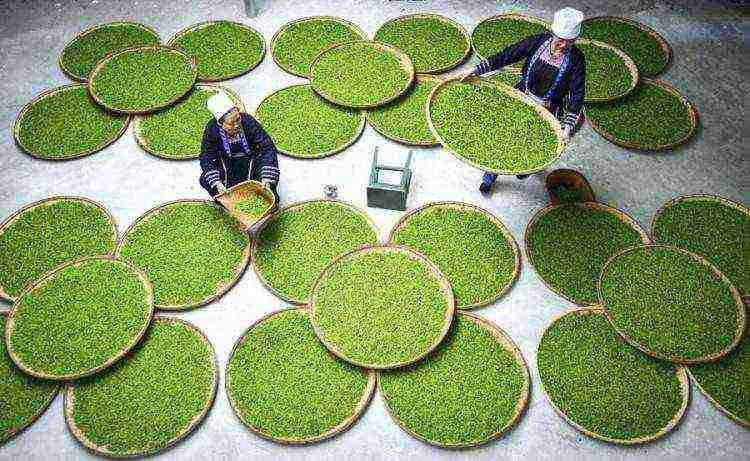
Drying of raw materials during fermentation
Oolong fermentation
One of the main differences in making oolong tea as a separate type of tea is the fermentation of its tea leaf. Depending on the level of fermentation, the oolong variety is determined.
Fermentation of tea is a natural biochemical process that occurs under the influence of atmospheric oxygen and bacteria that ferment the juice of freshly harvested tea leaves, therefore fermentation is sometimes called aging. The proper fermentation of oolong is facilitated by a special method of collecting and drying it.
Interesting to know!
Depending on the type of oolong, enzymatic processes should affect 15% to 50% of the surface of each tea leaf.
First of all, the edges, veins and lines of fracture of the leaf are subject to the process, which gives a special appearance to the oolong: the fermented areas are red, and the unaffected areas are green. This is what determines the varietal characteristics of the finished tea drink - it acquires a color from yellowish to dark red.
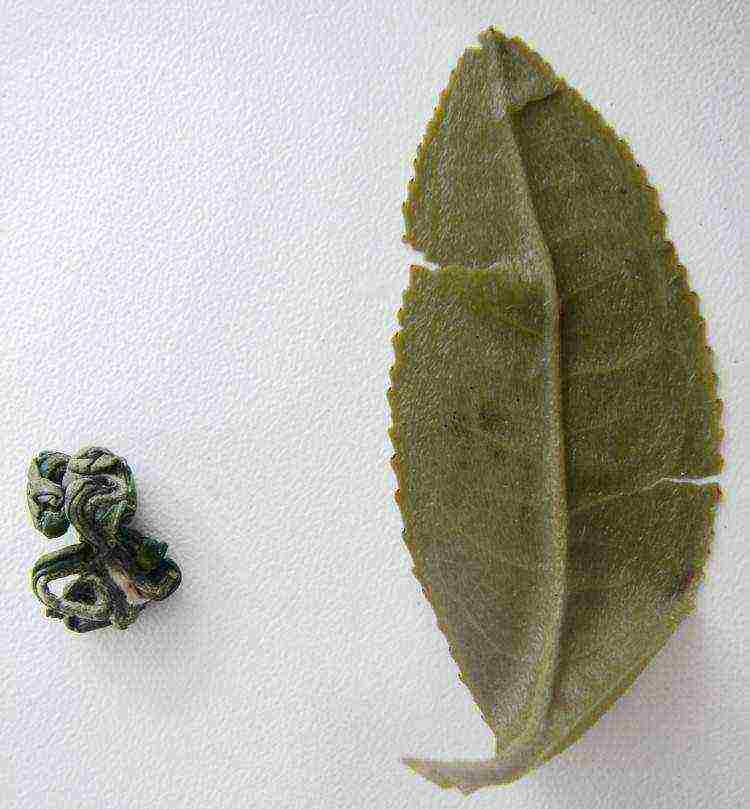
The difference in the size of dry leaf and brewed
Oolong making technology
For the production of oolong, different parts of the tea bush are used, depending on the type of tea to be made. As a rule, young shoots are used for low-fermented varieties, and adult leaves for highly fermented ones.
Within an hour, the raw material is dried in direct sunlight, then it is placed in thick layers in the shade for further fermentation. Raw materials are agitated every hour, mixed, then, when fermentation has reached the required level, it is stopped by heat treatment at a temperature of about 300 degrees.This treatment is carried out in two stages: after preliminary drying, when the leaves have not yet lost their elasticity, they are rolled into tubes or cubes, then dried.
This technique always allows you to determine the authenticity of the tea. Oolong tea is a whole leaf tea that reveals its red-green leaves when brewed. The presence of tea dust, fragments of leaves, tea crumbs in the package allows us to judge with confidence about its falsification.
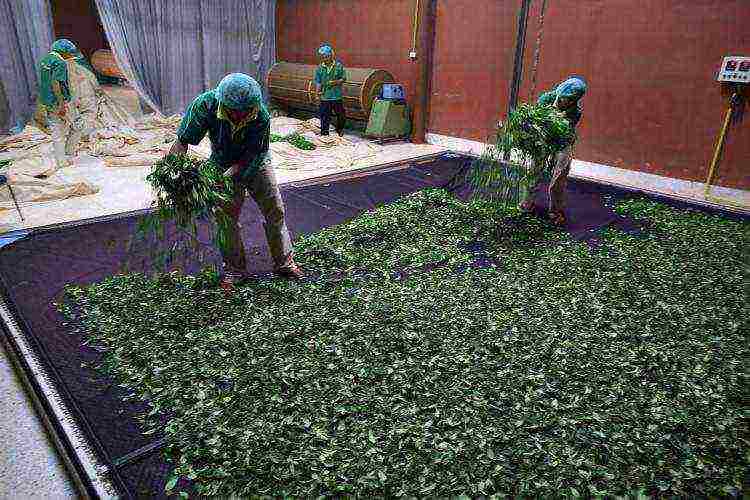
Every hour during fermentation, the raw materials need to be agitated
Famous Oolong varieties
The total number of varieties of Oolong is relatively small, which determines its value. In total, about 30 varieties of tea are used, we will briefly get acquainted with some of them.
- Tie Guan Yin... It belongs to the classic oolong varieties and is an indispensable drink in the Chinese tea ceremony. It grows on the mainland, in Fujian province.
Related Videos
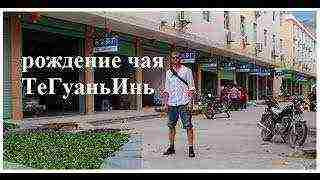
Oolong production of Tiguanyin
Click Play to view
- Guanin wang... It is a selected Teguanyin, which means "Imperial Teguanyin". Unlike classic teguanini, it can withstand repeated brewing without losing its peculiar honey-herbal aroma.
- Si Ji Chu - “spring of four seasons”. The raw material for making tea leaves is a bud of a young tea bush with two leaves surrounding it. Possesses an expressive spicy fruity aroma without milky tints. Unlike other teas, the raw materials for this are harvested four times a year,
- Xiang Jin Xuan, or milk oolong from island raw materials. Has a very deep aftertaste with an unobtrusive milk aroma.
- Gui Hua, or flower oolong. One of the most common oolongs with the addition of osmanthus flowers, which give the drink an original peach flavor. Flower oolong is most effective for quenching thirst,
- Huangjinggui - golden oolong. One of the earliest teas. It is characterized by a rich, tart taste, spicy, persistent aroma. The birthplace of golden oolong is Fujian.

Golden oolong has a slightly tart taste.
- Moli Oolong - jasmine oolong. It is a collection of young oolong shoots and jasmine flowers. It has excellent refreshing qualities that increase even the most disgusting mood. Jasmine oolong is recommended to be consumed after spicy and spicy dishes.
Oolong benefits
Oolong tea is one of the healthiest among the rich variety of Chinese teas. The finished drink contains a wide variety of essential oils that have a beneficial effect on mental balance and stimulate vital processes in the body.
A significant amount of caffeine, especially in highly fermented varieties, raises the general tone of the body and stimulates thinking.
Interesting to know!
Oolong drink contains a large set of vitamins (almost the entire palette of group B, also - C, D, E, K) and microelements (calcium, phosphorus, iodine, magnesium, zinc and others), which strengthens the walls of blood vessels, stimulates metabolism, removes harmful compounds from the body.
Regular consumption of oolongs helps to get rid of excess weight, which gives tea a special status as a means for losing weight.
Oolongs make up a very large tea group, which gives us the opportunity to experience the most unusual aromas and tastes: from subtle and delicate to bright and rich.
Distinguish types of oolongs by the region where they grew and by the degree of fermentation
Types of oolongs by region
According to the region of growth, oolongs are divided into mainland (Chinese North Fujian, South Fujian, Guangdong) and island (Taiwanese). Sometimes the island islands are called Formosa after the old name of Taiwan.
North Fujian
The Wuyishan Mountains, located in the north of China's Fujian province, are renowned for their beauty. There is a large number of Taoist and Buddhist monasteries, which have been involved in the cultivation, production and consumption of tea since ancient times.
Tea plants grow on rocks, and the local name for the resulting oolongs is yang cha, which means "rock teas". But recently, plantations have appeared near the rocks, on the sand.
The most famous varieties are Xi Da Min Tsun (White Rooster Comb), Da Hong Pao (Big Red Robe), Shui Jin Gui (Golden Water Turtle), Te Luo Han (Iron Sage)
South Fujian
In the south of Fujian province in Anxi County, tea has been grown since the Tang Dynasty. Oolongs are produced here with a low level of fermentation. Outwardly, they are greenish lumps of different shades.
The most famous local tea is Tie Guan Yin (Iron Goddess of Mercy). In other areas, this variety is also grown, but Tie Guan Yin from Anxi remains out of competition.
According to legend, this tea bush was donated by the goddess Kuan Yin to a peasant who has been caring for her abandoned temple for a long time.
Guangdong
Guangdong oolongs are made differently from Fujian oolongs.
They are called Dan Tsun - lonely bushes, since each bush provides raw materials with its own unique properties.
The aromas of these varieties are characterized by bright floral and fruity notes. They are usually named after flowers and fruits, which are similar to the aroma of the resulting tea. For example, Yu Lan Dan Tsun (lonely bushes with the scent of magnolia), Mi Lan Dan Tsun (lonely bushes with the scent of honey orchid).
When collecting, collect two or three sheets. They are twisted longitudinally, while the rest are twisted into spirals or balls. Green tea leaves with glossy sheen.
Taiwanese
They are very diverse in terms of terrain and method of processing.
The collection of raw materials in Taiwan takes place in late autumn, with the selection of Buds with several leaves. During production, the edges of the leaves are oxidized more strongly than those of Chinese ones. In dry tea, leaves of various shades with a visible white fluff. The infusions of Taiwanese oolongs have an amber color, a fresh aroma similar to that of green teas, and the taste is dense, honeyed, close to red.
The most famous varieties: Li Shan (Pear Mountain), Shan Lin Xi (Coniferous Forest Stream) Peng Feng (Eastern Beauty), etc.
Types of oolongs by degree of fermentation
According to the degree of fermentation, oolongs are subdivided into low, medium and highly fermented.
Weakly fermented (Bao-chzhong) give a transparent golden infusion and a strong aroma.
Medium fermented (Tie Gun Yin, Shui Xian, Dong Ding) - light brown infusion, very beautiful, intense thick taste and sweet aftertaste
An infusion of highly fermented oolongs (Bai Hao Oolong), orange in color with a strong fruity aroma.
Aromatization
Typically, tea leaves are naturally scented by drying them along with the flowers. Most often used for jasmine.
But there are oolongs that have their own natural milky flavor. These are expensive varieties from the Alishan mountains. With such specific aromas, the taste of the tea remains traditional.
Ginseng Oolongs are made by rolling tea leaves into ginseng root powder.

